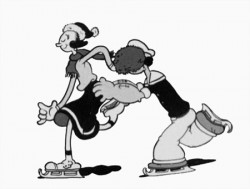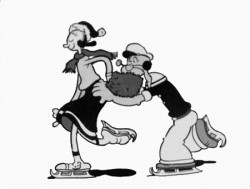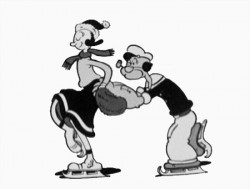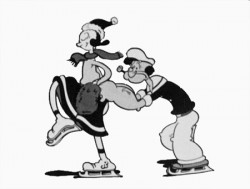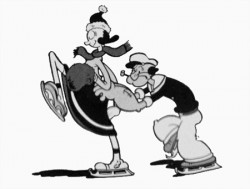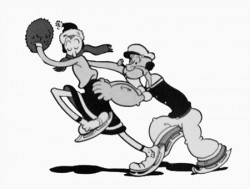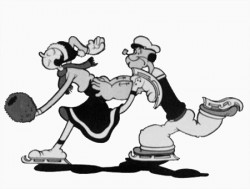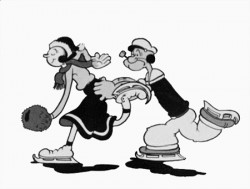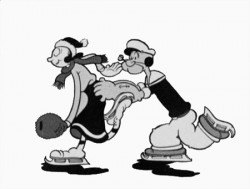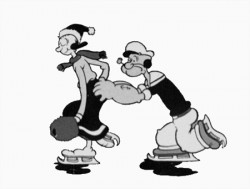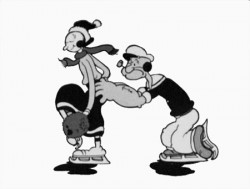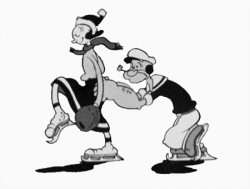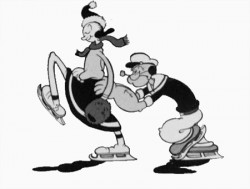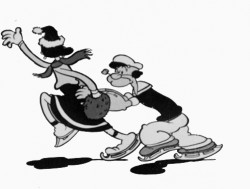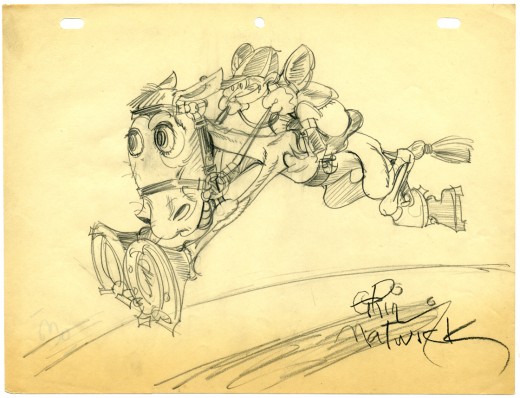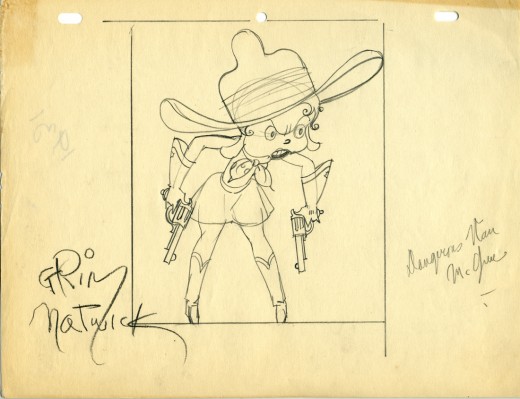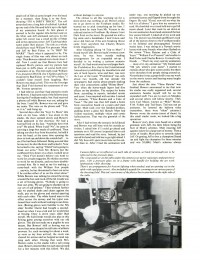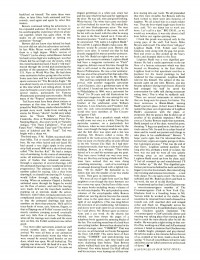Category ArchiveFleischer
Animation &Animation Artifacts &Fleischer &Richard Williams 02 Nov 2007 08:17 am
One Eye
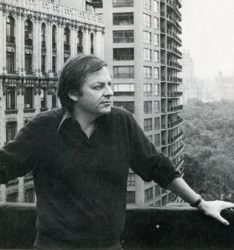 - While working on Raggedy Ann and being somewhat close with Richard Williams when he was in town, I was amused by something that happened early on.
- While working on Raggedy Ann and being somewhat close with Richard Williams when he was in town, I was amused by something that happened early on.
Dick was in and out often recording and editing the voice track. A lot of time was spent in the rehearsal studios in the Broadway/theatrical of town. (That was about three blocks away from the studio.) In an elevator ride up to the rehearsal space, Dick overheard a large black man in the elevator. I believe he was a delivery guy, maybe a messenger.
Dick popped up in a flash. He immediately asked the guy if he had ever done any acting. No? Well, Dick hired him on the spot to be the voice of the leader of the One Eyes. His voice was incredibly deep and dark.
Within the week, Dick had rerecorded the lines. (Another actor had done him in England, and Dick was looking for something better.) To be honest, I’m not sure if this was actually the final voice used in the film (it could be), but the story was so entertaining to some fly-on-the-wall like me, that I remember it well.
After recording the piece, Dick did a thank you drawing for the guy. I made a xerox. This is that copy done with drying magic markers.
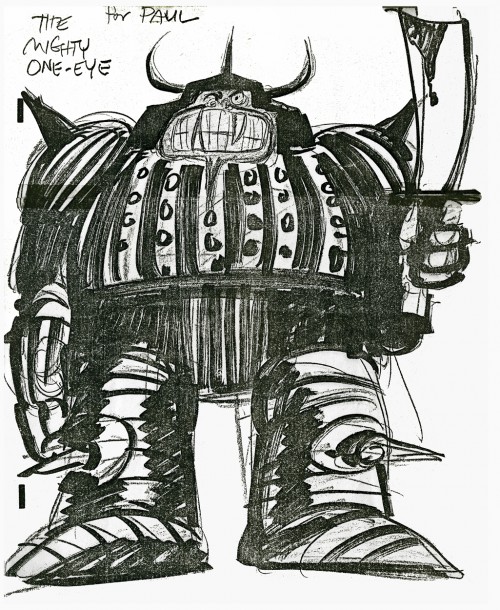
___________(Click image to enlarge.)
Sites to point to:
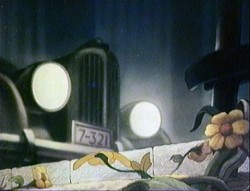 - Hans Bacher has created a new addition to his Animation Treasures. We now have Animation Treasures III. Look forward to more of Hans’ beautiful background reconstructions taken from the films themselves. He’s opened a wonder in his displays. I still go back often to view the many of the backgrounds (specifically Mr. Bug) that he’s revealed to us.
- Hans Bacher has created a new addition to his Animation Treasures. We now have Animation Treasures III. Look forward to more of Hans’ beautiful background reconstructions taken from the films themselves. He’s opened a wonder in his displays. I still go back often to view the many of the backgrounds (specifically Mr. Bug) that he’s revealed to us.
- Once again, Rob Richards continues similar work on a variety of films on his site, Animation Backgrounds. The many Alice In Wonderland backgrounds are enormously attractive on their own.
- As if you haven’t already heard about it, let me point you in the direction of Bob Jaques‘ new site Popeye Animator ID. Bob is enlightening us on the world of a lot of unfamilair animators. We know their names from the many credits we’ve read, but Bob is analyzing and detailing scenes that these artists have created. Names like Frank Endres, George Germanetti and Lillian Friedman become real as Bob gives us a lot of information that doesn’t seem to be located anywhere else. I’m also looking forward to Bob’s writing about Johnny Gentilella. This was the first real animator I met in the business and someone who helped me along the way. I’m always ready to hear more about Johnny Gent.
For this post alone (take a real good look at the tree) I’m grateful to Bob and his new site.
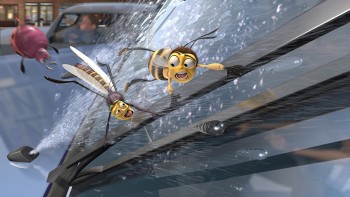 – Bee Movie opened today, and received mixed reviews in New York. The reviews I’ve read paint a brash, colorful, jokey sort of film, which makes it sound not unlike many animated films we’ve seen in the recent past. Who would have expected otherwise? The film gets a 50% rating on Rotten Tomatoes. I guess I’d call that mixed reviews. The feature in this film, I guess, is Jerry Seinfeld’s sardonic sense of humor. Perfect for the child in all of us.
– Bee Movie opened today, and received mixed reviews in New York. The reviews I’ve read paint a brash, colorful, jokey sort of film, which makes it sound not unlike many animated films we’ve seen in the recent past. Who would have expected otherwise? The film gets a 50% rating on Rotten Tomatoes. I guess I’d call that mixed reviews. The feature in this film, I guess, is Jerry Seinfeld’s sardonic sense of humor. Perfect for the child in all of us.
Jack Mathews of the NYDaily News said:
- If the movie proves anything, it’s that computers have gone past the ability to simply reproduce hues and tints and can now give the entire spectrum previously unperceived depth.
Kids are going to adore looking at this movie, living in it, flying through and above its brilliant landscape. It’s an animated joyride over a relief map of Manhattan.
I just wish the script was as good as the paint.
A.O.Scott in the NY Times writes a generally positive review with these few lines I’d like to point out:
- The DreamWorks Animation formula, exemplified in the mighty “Shrek†franchise (and imitated by would-be rivals at Sony and Fox), is to charm the children with cute creatures and slapstick action while jabbing at the grown-ups with soft, pseudosophisticated pop- cultural satire. “Bee Movie,†directed by Simon J. Smith and Steve Hickner and animated by several hundred industrious drones, pushes this strategy almost to the point of dispensing with the kid stuff altogether.
There are a few splendid cartoon set pieces … that show off the latest computer animation techniques. But most of the film’s creative energy is verbal rather than visual, and semimature rather than strictly juvenile.
There was an ASIFA East screening of this film on Tuesday. However, I chose to see another mediocre movie, American Gangster, on that date. I won’t get to see Bee Movie until next Tuesday, and maybe I’ll comment on it on Wednesday next.
Animation &Animation Artifacts &Fleischer 30 Oct 2007 08:19 am
Popeye cycle
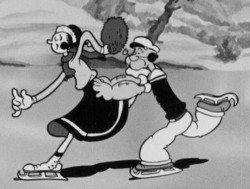 – Here’s a good example of something you won’t see animated in cgi. This is an ice skating cycle out of a Popeye cartoon, Seasin’s Greetinks!. It’s, of course, on the Popeye dvd just out, and is animated by Roland Crandall and Seymour Kneitel.
– Here’s a good example of something you won’t see animated in cgi. This is an ice skating cycle out of a Popeye cartoon, Seasin’s Greetinks!. It’s, of course, on the Popeye dvd just out, and is animated by Roland Crandall and Seymour Kneitel.
These Fleischer cartoons are so original in their jokes that there’s always a surprise or ten in every scene. The twists and turns are designed only to get laughs; I can give you a dozen examples from this short alone, but I’ll just recommend you watch the film.
It’s not just the stories that take odd spins, it’s the animation as well. There are bits that move in their own idiosyncratic way that are designed purely for laughs. Eccentric movements that would rarely show up in a Disney film dominate these Fleischer shorts.
Check out this cycle. Every eighth drawing is completely off the book. It gives the cycle a hilarious turn and completely dominates the move. It’s probably not the best way to build 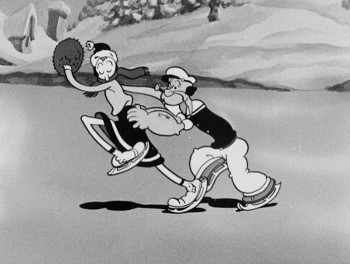 character (unless, perhaps, only one character moves like this), but it sure makes for some funny animation.
character (unless, perhaps, only one character moves like this), but it sure makes for some funny animation.
The thing about these Fleischer films is that it moves this way all the time. There’s always something about to take you for an odd turn, and while you’re looking for the big move, you’re just buying these small ones. The effect is cumulative, and the animation in these Fleischer films is just plain wacky.
A cgi animator doesn’t look for the odd twist in every frame. They can, but it wouldn’t make sense to be doing it that way, especially when the goal is to make the animation fluid in the final. The animation is too based on real life, and the individual frames don’t exist in the same way they do in 2D paper animation. There’s more risk in the 2D mode, but the reward can also be more ingenious and gratifying.
But what do I know? I don’t animate with cgi, and I’m just making a supposition based on what I’ve seen so far. Everything’s possible, but it sure doesn’t seem probable from my seat.
Having said that, let me also say that there aren’t too many animators doing 2D animation like this anymore. Maybe that’s the complaint I really have. Invention and daring in our medium seems to be a thing of the past.
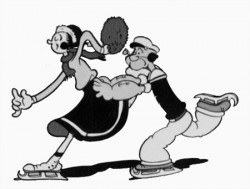 1
1 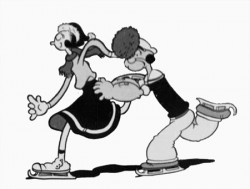 2
2
(Click any image to enlarge.)
Animation &Animation Artifacts &Fleischer 27 Oct 2007 08:27 am
Betty Drawings
- I promised to post all the Grim Natwick drawings of Betty Boop I have in my collection. A number of them aren’t specifically Bettys, but they’re pretty interesting just the same. Here’s a rough drawing of a jockey jumping done in 1931, signed by Grim. You can tell it was done in 1931 because he’s printed the date on the back (and you can see it bleeding through the paper on the lower left.)
Can anyone identify this cartoon?
As I said in the past, I’m very impressed by the holes punched in the paper. Whereas every other studio at this time was using a 2-hole punch for their paper, Fleischer was using this more sophisticated peg system. I don’t think Disney switched over to their 5 hole paper until 1934, and I’ve seen WB art still on 2-hole paper from 1938.
The other interesting item, noted by David Nethery on my last posting, is that they were using 8½ x 11 paper. Disney’s paper on Plane Crazy, two years earlier, was 9½ x 12. It’s amusing to note that many studios are back to drawing on 8½ x 11 paper today(unless they’re doing feature work) that is, if they’re still using paper.
Animation &Animation Artifacts &Fleischer 06 Oct 2007 08:03 am
Grim’s Betty – Dangerous Nan
- The Bum Bandit was a FLeischer cartoon starring Bimbo produced in 1931. It marks the fourth appearance of Betty Boop – who doesn’t get billing in the credits. As a matter of fact, she introduces herself with a different name during her song in the film, “I’m Dangerous Nan, the sister of Dan McGrew.” She’s so tough she spits bullets through a cactus.
Grim Natwick did the drawing, posted here. It’s dated 1931, the year of the film. The drawn Betty looks better than the film’s Betty. A lot was lost in the inking – including her scarf and guns. (I wonder if it was cleaned up for our delicate times?)
I like seeing the peg holes which are certainly more sophisticated than the two round holes used in other studios at the time.
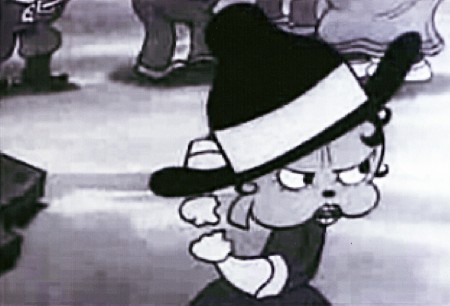
You can watch this film in an OK version on YouTube
(for however long they allow it to continue there.)
Comic Art &Commentary &Daily post &Fleischer 03 Jun 2007 08:11 am
Willard Bowsky et al
There are a number of interesting posts I’d like to call to your attention:
- First and foremost, Joe Campana on his site, Who and Where, has a post about Fleischer animator Willard Bowsky who died in battle during World War II.
Bowsky was a big guy at the Fleischer studio, and he’s rarely reaped the praise deserved for his work there. He was one of those at Fleischer’s who moved into the position of animator when there was a virtual exodus for the West Coast by many of Fleischer’s animators. Losing Dick Huemer, Sid Marcus, George Stallings and George Ruffle left only Ted Sears and Grim Natwick as animators. Suddenly Al Eugster, Shamus Culhane, George Cannata, Seymour Kneitel, Bill Henning and Willard Bowsky all received promotions.
Over the years I’d asked quite a few of the Fleischer veterans, who I’d met, for some information about Bowsky, but rarely did I get more than an anecdote about him.
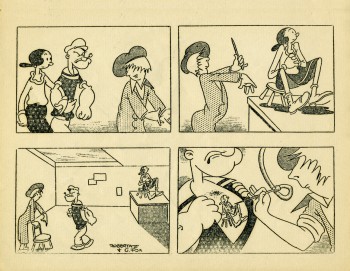 This is the sort of comment I heard. It comes from Shamus Culhane‘s book Talking Animals and Other People. (I’m not one to take Culhane’s usually biased comments verbatim, though undoubtedly there’s some truth in the statement.
This is the sort of comment I heard. It comes from Shamus Culhane‘s book Talking Animals and Other People. (I’m not one to take Culhane’s usually biased comments verbatim, though undoubtedly there’s some truth in the statement.
- Within a very short time some of the neophyte animators began to exhibit real talent as filmmakers. One was Willard Bowsky. He was about twenty-one at the time, a loudmouthed, opinionated fellow, who had a ready answer for every problem, political, artistic, or ethnic. He was probably the only person in the studio who was openly anti-Semitic. It didn’t seem to bother Max or Dave, even when people complained. While they admitted that it was probably true, they had none of the fierce defensiveness about Jewishness that developed later as a result of the rise of the Nazis.
According to the standards of the studio, Willard drew very well and had a great appreciation for contemporary music, so he was given sound tracks like “Minnie the Moodier” and “Stick Out Your Can Here Comes the Garbage Man.” He would even go into ecstasies over Cab Calloway records.
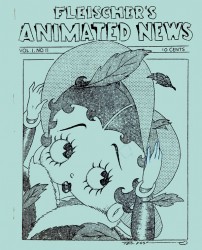 With my background of classical music, I thought Calloway sounded like jibberish and avoided those assignments like a plague. While Bowsky really couldn’t draw well enough to compete with West Coast films, he did make some of the better jazz cartoons in the studio because he loved the music.
With my background of classical music, I thought Calloway sounded like jibberish and avoided those assignments like a plague. While Bowsky really couldn’t draw well enough to compete with West Coast films, he did make some of the better jazz cartoons in the studio because he loved the music.
Willard lived at home with his parents and took no part in the usual Saturday night saturnalias. He was what one might call a pre-McCarthy, gung ho, ail-American Babbitt, an avid reader of the New York Mirror, with social convictions to match. He believed that all the unemployed were just being lazy, and intimated that anybody with ambition could succeed in this country, freely offering himself as a shining example.
Joe Campana really fills in a lot of gaps with his extraordinary post that details a lot of Bowsky’s life and final efforts during the war. Who and Where is becoming one of the better sites out there.
- I’m pleased to see that Will Finn has entered the Blog-writing fray. I love a good, new articulate voice to attend to. Check out his site. I’ve attached his link to my regulars. Thanks to Cartoon Brew for alerting us.
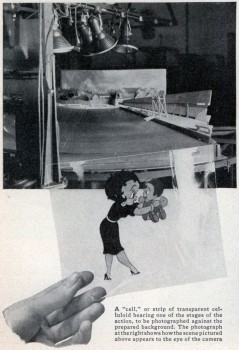 - Here’s an article from a 1936 issue of Popular Science showing how the 3D backgrounds were created for the Fleischer cartoons. The image to the left, obviously, comes from this article.
- Here’s an article from a 1936 issue of Popular Science showing how the 3D backgrounds were created for the Fleischer cartoons. The image to the left, obviously, comes from this article.
- Hans Perk posts on his blog A Film LA a 1936 Disney document about a “Gag File.” There’s always something new to dig up about the Golden Disney years. It’s a very interesting and provocative document.
 Blue Sky reports that the Tinkerbell film is finally shaping up having been wholly reworked by John Lasseter. This means that the trio of “Fairy” films can move forward. A cgi Tink, voiced by Brittany Murphy, will be coming our way. Can’t wait.
Blue Sky reports that the Tinkerbell film is finally shaping up having been wholly reworked by John Lasseter. This means that the trio of “Fairy” films can move forward. A cgi Tink, voiced by Brittany Murphy, will be coming our way. Can’t wait.
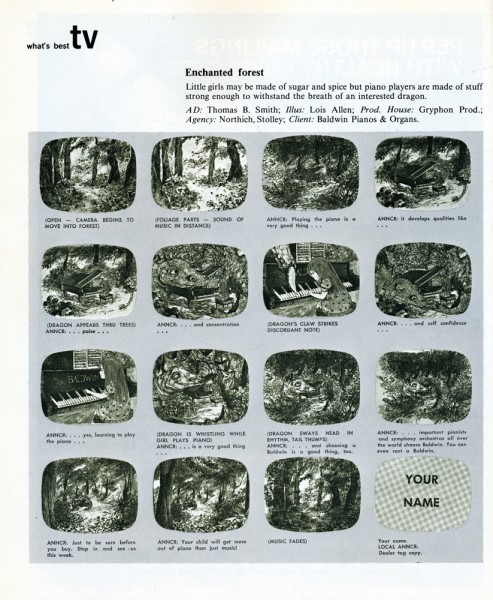 – Finally, I received an email from Howard Beckerman after meeting him at Amid Amidi‘s award ceremony. He said that he’d noticed my post which included the board by Gryphon Productions for Baldwin Pianos. (See the original post here.) Howard’s note reads:
– Finally, I received an email from Howard Beckerman after meeting him at Amid Amidi‘s award ceremony. He said that he’d noticed my post which included the board by Gryphon Productions for Baldwin Pianos. (See the original post here.) Howard’s note reads:
. . . I checked out your informative Splog and noticed Gryphon’s
. . . storyboard for the Baldwin Piano spot. It was directed by
. . . Ed Seeman and animated by Dante Barbetta and…me.
You never know what bit of info is going to turn up. It’s a great world.
Articles on Animation &Fleischer 13 Mar 2007 07:00 am
I.Klein’s Charles Bowers – part 2
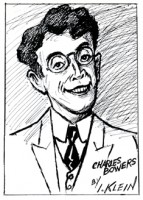 – So when we last left I. Klein yesterday, he was telling us about Charles Bowers. Bowers was a silent film animation pioneer and entrepeneur. He’s done enough that I think he deserves a little more attention by historians, but there isn’t much interest in and information about the silent film animators. Other than Winsor McCay, not too many early pioneers have been the focus of attention. Even someone as important as J.R. Bray remains a silent shadow in the corner of animation history overshadowed by the likes of Disney and the Fleischers.
– So when we last left I. Klein yesterday, he was telling us about Charles Bowers. Bowers was a silent film animation pioneer and entrepeneur. He’s done enough that I think he deserves a little more attention by historians, but there isn’t much interest in and information about the silent film animators. Other than Winsor McCay, not too many early pioneers have been the focus of attention. Even someone as important as J.R. Bray remains a silent shadow in the corner of animation history overshadowed by the likes of Disney and the Fleischers.
As a matter of fact, other than specific biographies (such as a book I have on Lotte Reineger or John Canemaker‘s books on McCay and Otto Messmer) I can only think of two books which focus on silent film animation. There’s the excellent book, Before Mickey by Donald Crafton, and there’s Walt In Wonderland by Russell Merritt and J. B. Kaufman. Both are must-haves for animation lovers.
Here then is the continuation of I.Klein’s article for Cartoonist Profiles’ June 1975 issue:
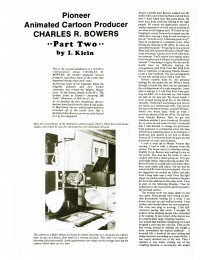 1
1 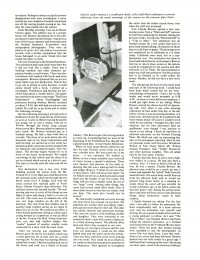 2
2
(Click any image to enlarge.)
Daily post &Fleischer 15 Feb 2007 08:24 am
Inkwells
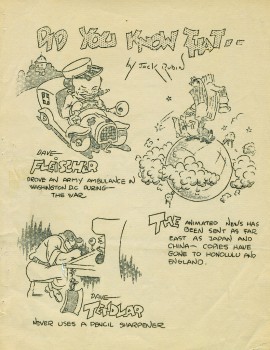 - G. Michael Dobbs has just posted the second chapter of his book on The Fleischer studio. It can be read on his site Made of Pen and Ink.
- G. Michael Dobbs has just posted the second chapter of his book on The Fleischer studio. It can be read on his site Made of Pen and Ink.
For those unfamiliar with this site, Dobbs has been writing this bio/animation history book for the last forever. He’s writing and posting it on the site one chapter at a time. Thus far we’ve had the prologue and chapters 1 & 2, and it’s already hot.
- In New York, there’s a lot of aniticipation for the Popeye dvd that’s scheduled to come out later this year. This is the one to be released by Warner Home Video/King Features and Hearst Entertainment. A lot of the animation community in New York were interviewed for an accompanying documentary for the disk. The doc is being directed by historian/film maker, Greg Ford, and should be pretty exciting.
(Click images to enlarge.)
Until then, there’s the Popeye’s Original Classics dvd which was released last year from Steve Stanchfield‘s Thunderbean Animation. As an added plus, if you buy this dvd you can hear the child version of me (1978) interviewing Jack Mercer about his Popeye Voice Overs. You can probably also use it to blackmail me.
This was originally a record that came with an issue of Mike Barrier‘s Funnyworld Magazine. it was supposed to be an incentive to buy the magazine, but I’m not so sure it worked. Regardless, I had a lot of fun doing it. I purposely chose Hal Seeger‘s studio, Channel Sound, to record the disk. That’s where they’d recorded a lot of the later Popeyes, and there were photos everywhere. Jackson Beck (Bluto) often stopped by to say hello. It’s also where I started out as a messenger going on asst. film editor.
 – Yesterday the news was all over the blogs about Peter Ellenshaw‘s death. Ellenshaw did all those wonderful glass matte shots in the Disney canon of live action films. The ships in Treasure Island wouldn’t have looked quite so beautiful if the surroundings weren’t Ellenshaw’s invention, and the rooftops of London – including that beautiful church steeple in the “Feed The Birds” sequence – of Mary Poppins wouldn’t have been so noble without his help. Nor the glens of Rob Roy, the town in Thomasina (my favorite Disney live action film), or the New England of Pollyana.
– Yesterday the news was all over the blogs about Peter Ellenshaw‘s death. Ellenshaw did all those wonderful glass matte shots in the Disney canon of live action films. The ships in Treasure Island wouldn’t have looked quite so beautiful if the surroundings weren’t Ellenshaw’s invention, and the rooftops of London – including that beautiful church steeple in the “Feed The Birds” sequence – of Mary Poppins wouldn’t have been so noble without his help. Nor the glens of Rob Roy, the town in Thomasina (my favorite Disney live action film), or the New England of Pollyana.
In 1979, the Museum of Modern Art had a show of Ellenshaw’s work with a lot of his matte paintings displayed, and he talked around a screening of shots he worked on from many of the films. I was struck with how impressionist the paintings were up close, yet on screen they looked so absolutely real. I asked about this, and he said that he found that the paintings had to feel a bit out of focus to achieve the effect of reality. When he painted in a very realistic mode, the paintings didn’t work.
The man knew what he was doing and was a master craftsman. Too bad that part of the film business seems to have died off. All effects now are “computer,” and I’m always so damned wistful for the past as I type this on my computer.
I’m sad to know he’s gone.
All this sniping going on between John Kricfalusi, Mike Barrier and Stephen Worth. Can’t we all just get along? It makes for entertaining reading, but it’s just getting too catty. Apparently the personalities don’t mix; I’m glad I’m not really involved. I notice the chat roooms are blistering with comments, but none of the sites seem to be discussing it.
Animation Artifacts &Daily post &Fleischer 01 Dec 2006 09:16 am
Mr. Bug Comes To Town for the Holidays
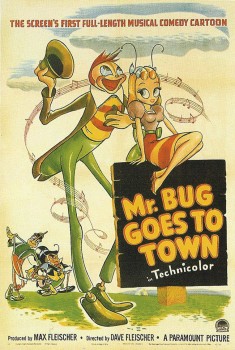 – Wednesday, I went to the Museum of Modern Art to see a screening of a new print of Mr. Bug Goes To Town. I didn’t quite expect a private screening; there were only four of us in the audience which seats a couple hundred.
– Wednesday, I went to the Museum of Modern Art to see a screening of a new print of Mr. Bug Goes To Town. I didn’t quite expect a private screening; there were only four of us in the audience which seats a couple hundred.
Over the holidays, from December 19 through January 2, MOMA is screening 10 family films. These include: Elf , Shrek, Babe, Meet Me in St. Louis, and The Adventures of Robin Hood, among others.
I first saw Mr. Bug when I was about 12.
It was shown at a local theater, and I couldn’t believe I hadn’t known about it. I had borrowed – in fact memorized – so many library books on animation, yet none of them had talked about it. (That was back in, roughly, 1958.)
The film was, to me, new and a gem.
This MOMA screening is the second time I was able to see the feature on a big screen, though I’ve seen it dozens of times on tv. (I own the dvd and a print and can watch it in 16mm, but that’s not quite the same thing.)
The film was a total flop when it was released in 1941. Pearl Harbor took place three days before its premiere, and the oncoming World War limited the distribution of most films. The European market was completely lost, and that represented 1/2 of the potential income. 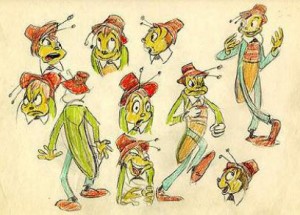
Paramount, under the leadership of Barney Balaban, took the opportunity to break up the Fleischer studio (they had obviously planned to do so in advance of the film’s limited release) and renamed it Famous Studios under the direction of Max Fleischer‘s son-in-law, Seymour Kneitel.
I’ve always loved aspects of the Fleischer studio animation. It’s so rooted in New York (despite the fact that the later stuff was done in Florida) that it absolutely screams out with an original charm of its own that completely separates it from Hollywood’s films.
The Fleischers obviously learned a thing or two from Disney, they stole a number of his animators (such as Grim Natwick, Al Eugster and Shamus Culhane) for Gulliver’s Travels and they brought Leigh Harline (who’d won the Oscar for Pinocchio) in to compose the film’s score and Pinto Colvig (the voice of “Goofy” did voices for both Fleischer features.)
Seeing the film again on a big screen accentuated the background styling of Robert Little. Given the closeup nature of the film, following small bugs about, the Backgrounds consistently fake a low depth of field look, as if it were a live action film. The backgrounds, with very few exceptions, are painted with at least 1/3 – usually more like 2/3 – painted out of focus. At first, I thought they were using some type of multiplane device to put areas of the bg’s out of focus. No, on the big screen you could see the texture of the paper or random specks of paint – clearly in focus. The effect is to highlight the characters and give a focal point for the audience. Brilliantly done.
Also there’s one beautiful point where they fade out the scene – to about 90% black – while keeping a small iris around the little bug at the piano. This before they fade out the entire scene. It’s an effect Martin Scorsese uses in The Departed, but Mr. Bug was done 70 years ago. They’re beautifully exploiting a silent film technique for dramatic purposes. 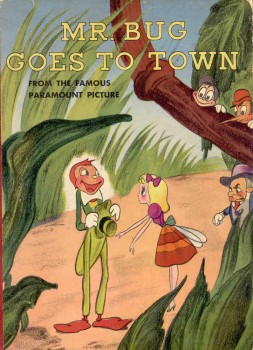 It’s an important film, and those who can make it in January should go.
It’s an important film, and those who can make it in January should go.
I posted some material from Mr. Bug Goes To Town back in February (a children’s book and sheet music).
Go here to relive that posting.
But back to MOMA. The film’s a beauty, and the print is good (some scratches but a beautiful IB Technicolor print.) The screening for the public will be on Jan 1 at 11:00 & 2:00. It’s a great way to start the New Year.
Mr. Bug Goes to Town (1942) Directed by Dave Fleischer. Screenplay by Dan Gordon, Tedd Pierce, Isidore Sparber, William Turner, Carl Meyer, Graham Place, Bob Wickersham and Cal Howard.
(Click on any image to enlarge.)
MOMA‘s complete holiday family film schedule is as follows:
- Elf Tuesday, Dec 19 Noon & 3:00
Big Saturday, December 23 and Sunday, Dec 24 Noon
The Adventures of Robin Hood Tuesday, Dec 26 11:00 & 1:30
Shrek Wednesday, Dec 27 11:00 & 1:30
Wallace and Gromit: The Curse of the Were-Rabbit Thursday, Dec 28 11:00 & 1:30
Babe Friday, Dec 29 Noon & 2:00
Madagascar Saturday, Dec 30 11:00 & 1:30
Ghostbusters Sunday, Dec 31 11:00 & 1:30
Mr. Bug Goes to Town Monday, Jan 1 11:00 & 2:00
Meet Me in St. Louis Tuesday, Jan 2 11:00 & 2:00
Daily post &Fleischer 13 Oct 2006 09:16 am
Friday the 13th
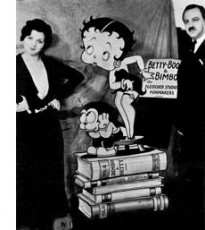 – I’d like to remind you that Mike Dobbs is continuing to post his biography of the Fleischer brothers as it’s written. You can find this on his site, Made of Pen and Ink.
– I’d like to remind you that Mike Dobbs is continuing to post his biography of the Fleischer brothers as it’s written. You can find this on his site, Made of Pen and Ink.
The former editor of Animato and Animation Planet posted his Introduction several weeks back and has just added Chapter One to the site.
Since there hasn’t been much done exclusively about this very prolific studio, it’ll be welcome. I have Out of the Inkwell, Richard Fleischer’s biography of his father, Max. I also have Leslie Carbaga’s fanzine of a book, The Fleischer Story.
Neither of these books is very critical, so it’ll be interesting to see how Mike Dobbs’ work will grow. With all the work he’s done over the years, it certainly should be the authoritative version. Check it out.
- Jenny Lerew, on her site Blackwing Diaries, has posted an excellent comment on women at the Disney studios. This is something of a theme she’s been developing, and it’s wonderful. I look forward to everything she has to say.
She uses this posting as a way of talking about the “See Jane/Union “Where The Girls Aren’t” panel which she’d attended. Events like this, as described by Jenny, make me momentarily sorry I don’t live in LA.
- If you haven’t found it yet, Tony White has set up the Animaticus Foundation and a new site to go with it. It’s apparently dedicated to 2D animation and is a good start with plenty to view and a promising forum on which to chat and leave comments. (Thanks to Dave Nethery for highlighting on his site.)
- Today, the NYTimes has a review of the exhibit, Master of American Comics, currently on view at the Jewish Museum in NY and the Newark Museum. A show worth visiting.
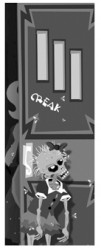 - Friday the 13th, and it’s appropriate for me to have received my weekly notice from Jason McDonald re the latest edition of his online comic strip, My Living Dead Girl.
- Friday the 13th, and it’s appropriate for me to have received my weekly notice from Jason McDonald re the latest edition of his online comic strip, My Living Dead Girl.
This has to be the first retro-minimalist comic. Jason has always been a fabulous graphic artist, and he’s letting it all loose in this strip.
Unfortunately, you’ve missed quite a few episodes of the strip, but if you go back into his archives, you can catch up. He also has a number of other things to check out including merchandise for sale.
Jason has done quite a bit of art for my studio over the years; some of it appears on his main site, Jason McDonald Design (also worth checking out).
In the next week, I hope to highlight some of Jason’s work which he did for my studio.
(Images enlarge marginally when clicked,)
Daily post &Fleischer 05 Aug 2006 08:55 am
Fleischer / Comments
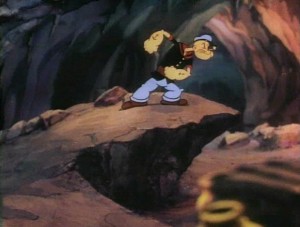 Mike Dobbs, the former editor of Animato and Animation Planet, has fashioned a new blog / site to give us a view into the book he’s writing on Max & Dave Fleischer.
Mike Dobbs, the former editor of Animato and Animation Planet, has fashioned a new blog / site to give us a view into the book he’s writing on Max & Dave Fleischer.
It’s called Made of Pen and Ink. To quote him about the new site: It’s the first draft of my book on Max and Dave Fleischer, their cartoons and studio. It will be posted a chunk at a time without illustrations in the effort of pre-selling to an audience and attracting a publisher.
I’ve read Mike’s other site, Out of the Inkwell , regularly and appreciate his comments. I’m looking forward to  his honest commentary and valuable information about the Fleischer history.
his honest commentary and valuable information about the Fleischer history.
- Michael Barrier has an amusing take on the commentary tracks for animation DVD’s. He jumps off the letters and comments he’s received for the commentaries he’s done for the WB Golden Collection DVD’s.
One wonders how many people won’t really get this joke.
